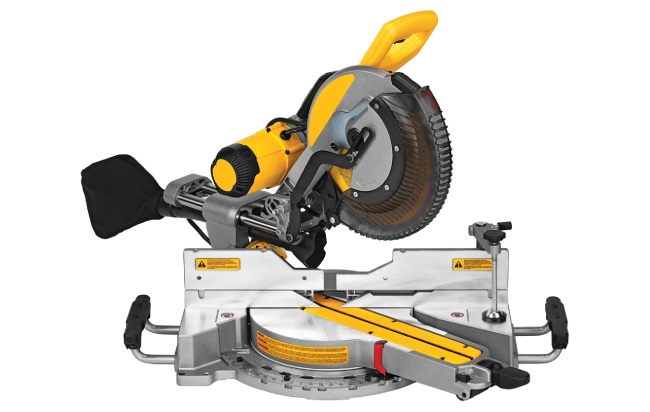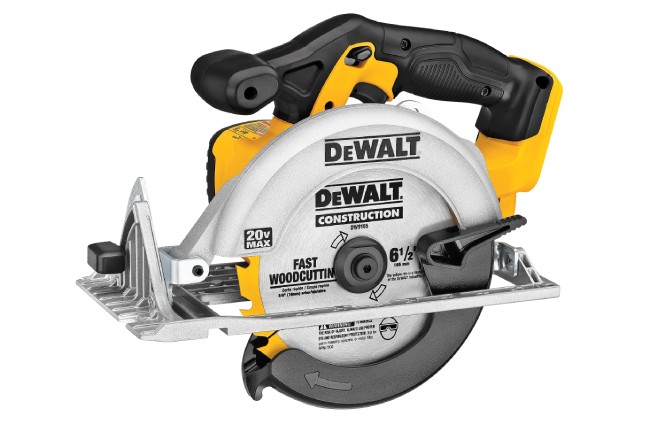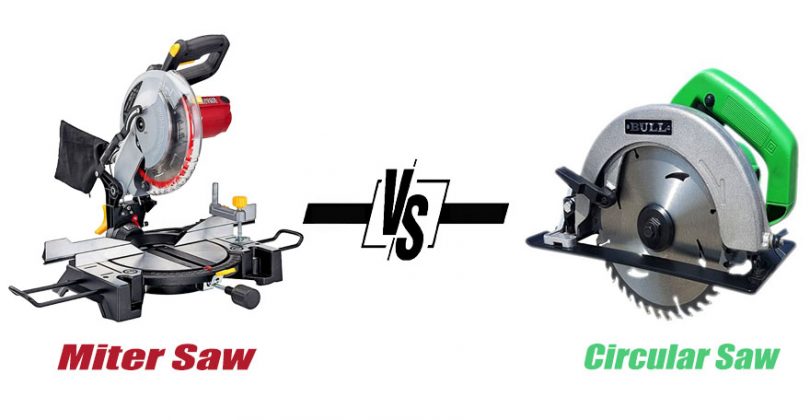If you’re wondering whether you should own the miter saw or the circular saw or both, you’re now exactly where we were decades ago. Based on our experience, we know that this depends on a number of factors.
Here we’ll discuss all those factors and describe what both these types of saws are really capable of.
Miter Saw

Miter saws are a type of power saw that can cut wood and turn a raw piece into a valuable asset.
Using it is simple: a handle is used to pull its blade down onto the workpiece to make cuts.
The saw can make accurate cross, miter, bevel, and compound cuts (miter and bevel cuts). Moreover, it uses “stops” at different angles (from 0° to 90°).
Circular Saw

Circular saws are also power saws. Unlike miter saws, it can cut hard materials like metal. It uses different blades for different materials: for example, an abrasive blade for concrete and metal. Yes, you can cut concrete with a circular saw and get results just like those from your concrete saw.
The saw’s great at slicing rip and cross cuts, or their combination. It mostly comes in a free hand style, but it can also be configured as a table top.
Miter Saw vs Circular Saw
1. Cost
There’s a huge difference in the cost between these two types.
A miter saw, with its well-crafted design and conventional and balanced cutting, is more expensive. Its price range is $200 to $600. Your money will be well spent if you want more precision.
In contrast, a circular saw is nowhere near that expensive; its range goes from $40 till $100. If your purpose is making cross cuts or rip cuts, then this saw is ideal, but it requires skillfulness.
2. Ease of use
This is an important distinguishing fact between the two saws.
A miter saw is easy to use; its precision is the key for beginners. You can adjust its angles. Its “stops” allow you to quickly adjust it on different angles (like 15°, 30°, and 45°).
A circular saw is more difficult to control. Yes, it’ll give you more versatility when cutting different materials, but handling its swivel motion manually is challenging. Plus, you have to make the angles yourself.
3. Prior Skill
A miter saw requires no prior skill; just go through the guide to understand its technique. Its fixed setup and multiple functions, like setting up the angles for different cuts, make it effortless.
On the other hand, a circular saw needs more skill, as it doesn’t contain any of these automatic traits. Everything’s up to you. You must understand its motion, force to be applied, and how to keep the balance when driving it in an angled motion.
4. Working Principle
A miter saw, with its common size blade (8-12’), comes downward to make a cut where the miter vise holds the workpiece and cuts it by holding the saw’s handgrip and quickly bringing the blade down.
Whereas, a circular saw isn’t fixed. Although, in some types like the table top, it’s fixed. In this cutting, the blade is gradually run across the workpiece following a straight line. In a table top circular saw, a workpiece is usually dragged into the fixed blade.
5. Types of cuts
There’s a variety of cuts that these two master in.
A miter saw is a great call for making cross and miter cuts with great precision and trimming quality. It gives excellent control and clearing while making the bevel and compound cuts.
A circular saw is what you call versatile when it comes to the rip cuts and long straight cuts, either along the grain or against the grain. It can make all of the miter saw’s cuts, but with less accuracy.
6. Storage and Portability
Unfortunately, many types of the miter saw are not portable. The portable ones require great effort and need to be loaded in a truck or car or trolley. Moreover, they require greater space in your workshop, but their precision covers this loss.
Whereas, a circular saw proves to be more space saving. It can fit in your bag, and become a part of your portable toolkit. It can also be used as a table top saw.
7. Weight
There’s a huge difference regarding their weights.
A miter saw is not only larger but also heavier. It’s available in different weights from 30 to 50 pounds. It can help in bigger projects where you need accuracy.
A circular saw is portable, small, and lightweight; it weighs up to 8 pounds. There are hardly any models that weigh equal to or more than 8 pounds. You can even carry one in your backpack.
8. Safety concerns
A miter saw is very user friendly; it’s safe to use because you can keep your hands away from its blades. Additionally, it’s fixed, so there will be no chance of dropping it or losing control, proving better for a beginner.
Circular saws are risky to handle and could cause serious injuries, so you must be very cautious and well-trained. Keep your hands steady and don’t let them slip. To avoid any injuries, learn properly before using it.
Pros and Cons
Miter saw Pros
- It gives the most accurate cross, miter, bevel, and compound cuts.
- The trimming of tight-fitting joints (doors, windows, crowns shaping) will be unmatched.
- This will prove skillful for angled cuts; there will be certain stops on different angles where you have set up the required angle.
- This can save you a serious amount of time, with sharp 10 to 12 inches circular blades and wider cuts that it makes rapidly.
- It’s safer than the circular saw, hence friendly for beginners.
Miter saw Cons
- It’s not as versatile as the circular one; it’s restricted to a variety of cuts and cannot go further than those cuts. Rip cut and cutting plywood are out of its reach.
- It’s way too expensive; you can get a circular saw for even less than half of its starting price.
- It takes up a lot of space. So, clearly, it will not be a choice for those who are having small workshops; plus, it’s not portable.
Circular saw Pros
- It might not give you much precision but it definitely provides you more versatility. It uses different blades to cut metal, steel, plastic, and wood. Moreover, rip and straight cuts, along with or against the grains, can be made with it.
- It’s much cheaper; you can buy one for even $40.
- One of its best features is that it’s portable and a lot lighter than the miter saw. Hence, it can be added to your portable toolkit.
Circular saw Cons
- There are no “stops” for angles. Therefore, it cannot offer detailed curved cuts; this means you have to measure an angle manually and hope for precision.
- It takes more time than a miter saw because of self-measuring cuts and angles.
- It requires a great pack of skills because of it being less safe. This makes it a skillful person’s job, and not one for amateurs. It takes a lot of practice to master, and even after that, it’s dangerous.
Who Should Buy What?
It really depends on your needs; both are excellent and have their sole importance.
Don’t hesitate to buy a miter saw if: you want to make cross, miter, bevel, and compound cuts with precision, are looking to spend some extra money, and have extra room for its setup.
Additionally, it provides better trimming ability. For all these reasons, a miter saw is the right choice for your workshop.
However, if you’re looking for a cheaper ride and still get the work done, then a circular saw will offer you everything that a miter saw offers. Plus, it’ll also rip a straight cut with little less precision than the miter saw. In addition to this, you can put the circular saw in your bag and travel with it. You just need to be a little more skilled to use this, and the key to this is extensive practice.







